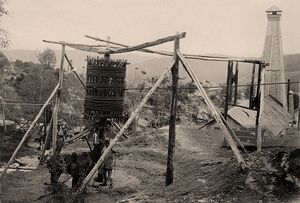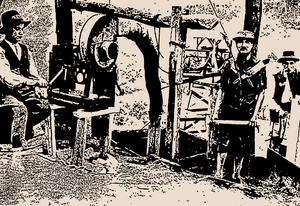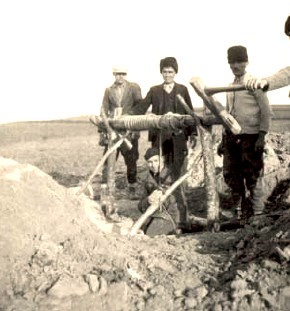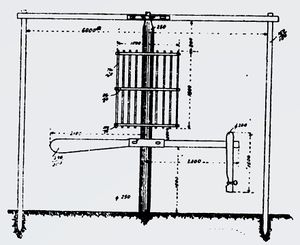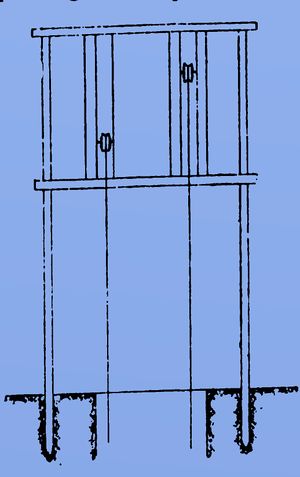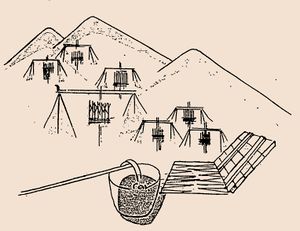Hecna
The original version of this article was created by Francesco Gerali, 2020 Elizabeth & Emerson Pugh Scholar in Residence at the IEEE History Center
It is recommended this article be cited as:
F. Gerali (2020). Hecna, Engineering and Technology History Wiki. [Online] Available: https://ethw.org/Hecna
A hecna is a capstan made of wooden slats and osiers moved generally by means of a horse (Fig 1); it was used to lower and raise men and tools in the wells (Fig 2 and 3). This animal traction vertical-shaft pulley (called alternatively vertical-axle winch) was more practical to work on wells deeper than 50 meters than the manual horizontally displaced winch commonly used in the other European petroleum fields (Fig 4). The utilization of beasts of burden (largely horses, from this the expression hecna cu cal - hecna with horse, is derived), together with the large capstans made it possible to move heavier loads at faster speeds. The majority of the early Romanian petroleum wells were in soft ground, which made the process of digging easier and faster: the combination of skilled diggers and agile hecna made the operation more rational and cost effective.
"Hecna" is the original Romanian term; in French - the most widely spoken foreign language in Romania at the time - it was known as manège; in English the term is almost unknown and the closest translation is carousel. The introduction of the hecna in petroleum digging and exploitation dates to around 1870 in the wells of Păcureţi (Prahova district) owned by the entrepreneur Mr. Mateescu, who had seen the hecna working at the Slănic saltworks for extraction of salt. Soon after, well diggers brought this technology from Pacureţi through the other fields of Romania, which became the historical icon of the early petroleum industry of the country. [1]
The hecna consists of two distinct parts: the porumbarul (the drum, vertical and cylinder-like shaped) and the gratarul (the frame which holds the drum). The drum is the device on which wind up the cables that support the skips, and it is fixed on a vertical spindle that swivels on a pad, in a wooden frame. The cables wind in the opposite direction, one at the top, the other at the bottom of the drum. The inner structure of the drum is made of three wooden crosses fixed on the main axle, and distanced one meter from each other on the vertical, and sometimes are reinforced by struts. At the ends of the wood of the cross are fixed wheels tongue and mortise on which are nailed the laths that form the drum shell (Fig. 5) . The drum is raised to a height of 1.8 - 2m above the surface of the ground, so that a horse can spin below. The spindle is provided at the lower end with an iron frame with a peg which enters a nut; the latter is fixed to a wooden trunk driven into the ground. Under the drum, at the lower part of the spindle and perpendicular to it, a lever arm of a length ranging from 3.50 up to 4.50m is fixed. At one of its end it ends a vertical arrow to which a horse can be harnessed to move the hecna; the opposite end ends with a heavy head to keep the whole structure in balance. The rod is rigid on the vertical spindle so that it drives in its movement the spindle with the drum, on which the cables are wound and unwound. The cable from the drum is led into the well by pulleys mounted on a wooden trestle (Fig. 6). This is a frame made of oak boards and parts arranged in such a way that two pulleys can be mounted at different heights. It is placed exactly above the mouth of the well, and at the same height as the frame of the drum, to which it is connected by stringers, so that the whole system acquires greater stability.
The hecna are entirely built in wood and have just a minimum number of iron nails on them. The diameter of the drum usually varies from 1.3 to 1.6 meters, size which, depending by the the strength of the horse, allows it to trot at normal pace and raise loaded buckets quite easily. The usual distance between the drum and the trestle may vary between 5 and 6 meters. Very often, the same well diggers build hecna by themselves on the site where they plan to sink the well. For these constructions, we do not conform to a fixed type, we let ourselves be guided above all by the position of the well and the configuration of the land (Fig. 7). The price of a fully assembled hecna was about 80-90 French francs, including equipment, which corresponds to some $450-500 in modern (c. 2020) currency.
See also
- Spring Poles
- Pump Jacks
- Glossary of the Technical Terminology Used in the Petroleum Industry, 1890 - 1950
References
Anonymous. 1955. The centenary of Rumania oil industry. Bucharest: Foreigner Language Publishing House.
Edeleanu, L. 1907. Le pétrole Roumain, sa composition et ses propriétés physiques et techniques - The Roumanian petroleum, its composition and physical and technical properties. Bucarest: EMINESCU.
Gerali, Francesco, Gregory, Jenny. 2017. “Understanding and finding oil over the centuries: The case of the Wallachian Petroleum Company in Romania.” Earth Sciences History: Journal of the History of the Earth Sciences Society 36, no. 1: 41-62.
Jordan, Constantin. 1955. The Romanian oil industry. New York: New York University Press.
Stoicescu, Maria, Ionescu, Eugen Mihail. 2014. Romanian Achievements in Petroleum Industry. Conference Paper. CBU International Conference on Innovation, Technology Transfer and Education February 3-5, 2014, Prague, Czech Republic.
Tănăsescu, Ion, Tacit, Virgil. 1907. Exploatarea petrolului in Romania. L'exploitation du pe︠trole en Roumanie. Bucureşti: Institutul de arte grafice "Carol Göbl".
Lahovari, George Joan, Brătianu, Constantin I., Tocilescu, Grigore George. 1902. Marele dicţionar geografic al Romîniei alcătuit și prelucrat dupa dicţionarele parţiale pe judeţe. Bucureşti: Societatea geografică română.
